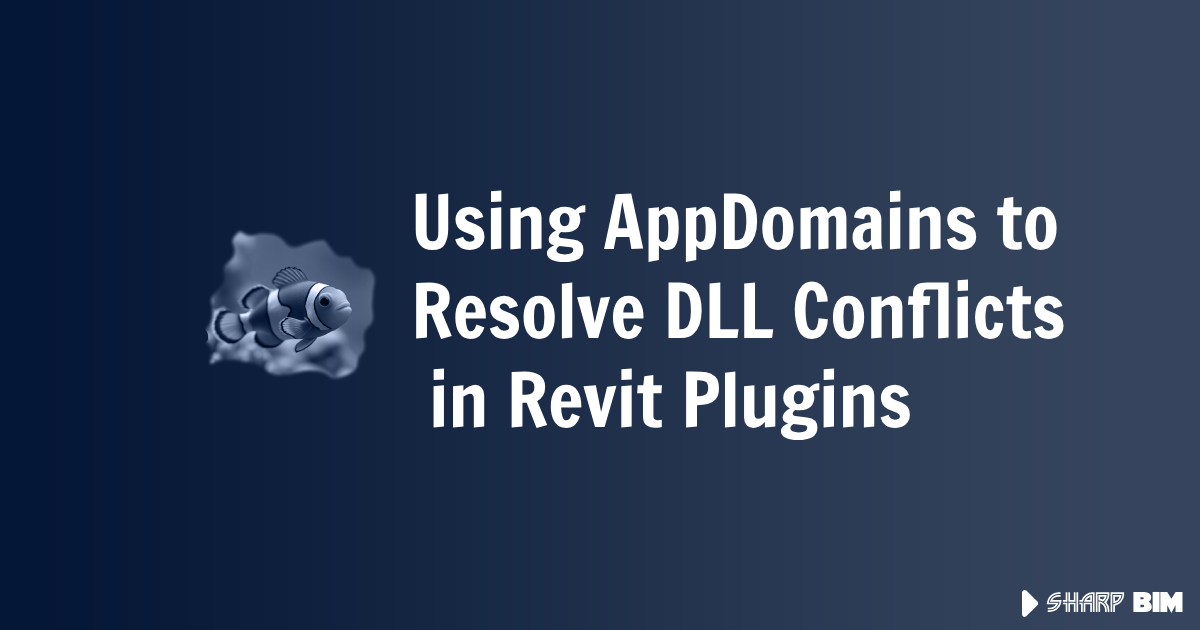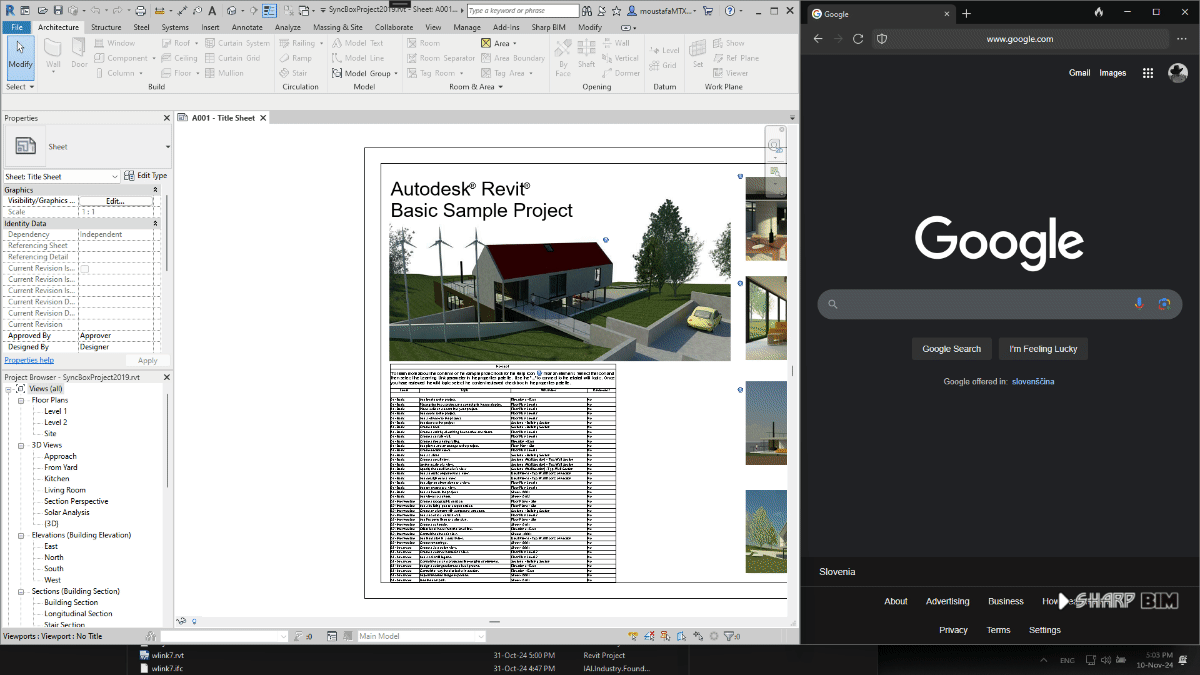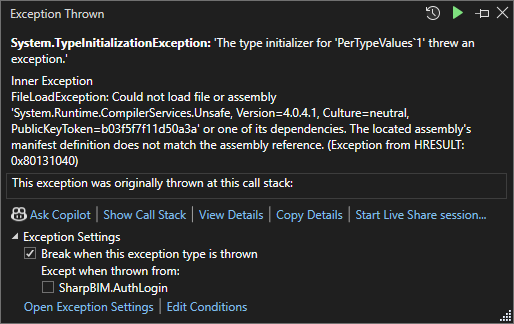Using AppDomains to Resolve DLL Conflicts in Revit Plugins
 Moustafa Khalil
Moustafa Khalil
DLL Hell—a persistent challenge for .NET Framework developers—becomes particularly thorny when creating add-ins for complex applications like Revit. Juggling dependency versions often leads to cryptic conflicts, as each DLL expects a specific version to be present. I recently faced this issue while integrating Auth0.Client into a custom login process for a Revit 2019 add-in. Revit's preloaded dependencies clashed with those required by Auth0.Client, presenting an intriguing challenge: how to make these libraries cooperate without compromising Revit's core functionality.
While not identical to other DLL conflicts discussed on the Autodesk forums here and here, this issue shares similar principles. Here's my journey from initial stumbling blocks to an elegant AppDomain-based solution.

The Problem: Conflicting Versions of System.Runtime.CompilerServices.Unsafe.dll
In this particular case, the Auth0.Client library required System.Runtime.CompilerServices.Unsafe.dll version 6, but Revit 2019 was locked into version 4. Revit preloads its version at runtime, which led to a missing method exception when Auth0.Client tried to call a method only available in the newer version. Classic DLL Hell.

Standard Solutions (That Didn’t Work)
Initially, I tried several conventional workarounds:
AppDomain.AssemblyResolveEvent: This is often the first recourse in resolving assembly issues, but it fell short. Revit’s own assembly binding order took precedence, loading version 4 of the DLL before any alternative could be set.Forced Load Order: I tried forcing the correct DLL version to load before Revit’s, by simply adding
Assembly.Loadat theOnStartoverload function, but this proved futile since Revit wouldn’t relinquish its hold on its preferred version.Config File Binding Redirects: Editing
Revit.configand using my Dll application config fileSharpBIMAddin.dll.configwith binding redirects was another attempt, but Revit’s built-in DLL handling prevented this from working as intended.
It quickly became clear that a new approach was needed—one that would allow the Auth0.Client library to operate within its own ecosystem, without impacting Revit’s core environment.
The Solution: Isolated Execution with AppDomains
Metaphorically, using AppDomain in Revit is like placing a fish (the conflicting DLL) in a water-filled, transparent sack (the isolated AppDomain) inside a larger aquarium (the Default AppDomain). The fish can swim in its own water without disturbing the rest of the tank, just as the isolated AppDomain lets the DLL operate with its specific version requirements without impacting Revit’s internal dependencies. This "sack in an aquarium" approach preserves harmony in the larger environment while meeting the unique needs of each element.

AI Generated Image
After trying conventional methods without success, I found that crteating an isolated AppDomain was the most effective solution. This separate domain loads and manages Auth0.Client and its dependencies independently, bypassing Revit’s locked-in version requirements. Below is a breakdown of the implementation, which turned a major compatibility roadblock into an elegant, sustainable solution.
var authService = UtilityHelper.LoadAssemblyViaAppDomain<AuthSandbox>(dllPath);
authService.LoadAssembly(dllPath);
string result = "";
try
{
result = authService.ExecuteLogin();
authService.Dispose();
}
catch (Exception)
{
// something went wrong
}
Step 1: Encapsulating Login Logic in a Separate DLL
I placed all login-related code in a standalone library that would handle only the authentication process, outputting a JSON-formatted result. This approach ensured a clear separation between Revit’s operations and the login functionality, making it easier to manage dependencies.
Step 2: Creating and Configuring a New AppDomain
By configuring a new AppDomain, I could load only the specific DLL versions needed for Auth0.Client, without interference from Revit’s preloaded dependencies. The following snippet shows how the new AppDomain is set up:
public T LoadAssemblyViaAppDomain<T>(string targetDll) where T : AssemblySandbox
{
var domSetup = new AppDomainSetup
{
ShadowCopyFiles = "ShadowCopied",
ShadowCopyDirectories = "ShadowDires",
CachePath = Path.GetTempPath(),
ApplicationBase = Path.GetDirectoryName(targetDll)
};
AppDomain domain = AppDomain.CreateDomain("IsolatedDomain", null, domSetup);
Type assemblySandboxType = typeof(T);
var assemblySandbox = (T)domain.CreateInstanceAndUnwrap(
assemblySandboxType.Assembly.FullName, assemblySandboxType.ToString());
domain.DomainUnload += assemblySandbox.Domain_DomainUnload;
assemblySandbox.Domain = domain;
return assemblySandbox;
}
This setup utilizes AppDomainSetup with shadow copying enabled, making it possible to isolate DLLs effectively. The AppDomain.CreateDomain method dynamically creates a unique domain, allowing Revit to maintain its ecosystem while Auth0.Client manages its own.
Step 3: Implementing a Sandbox Class
The next step involved creating a sandbox class inheriting from MarshalByRefObject. This class enables safe, cross-domain communication. Here’s how I structured it:
public abstract class AssemblySandbox : MarshalByRefObject
{
protected AppDomain Domain { get; private set; }
public AssemblySandbox() { }
public void SetDomain(AppDomain domain)
{
if (Domain == null && domain != null)
{
Domain = domain;
Resolver = new AssemblyResolver(Domain);
Domain.DomainUnload += Domain_DomainUnload;
}
}
public abstract void LoadAssembly(string assemblyPath);
....
}
The AssemblySandbox class encapsulates methods for assembly loading and cleanup, keeping the isolated domain’s lifecycle under tight control.
Step 4: Loading and Using the Login Library in the New Domain
With the isolated domain and sandbox class in place, the final step was to load the login library, call the authentication method, and retrieve the result. Here’s how it all comes together:
public class AuthSandbox : AssemblySandbox
{
public string ExecuteLogin()
{
CancelToken = new CancellationTokenSource();
var result = _authService.Login(CancelToken.Token);
result.Wait(60000, CancelToken.Token);
CancelToken.Cancel();
var userResult = result.Result;
result.Dispose();
return userResult;
}
public override void LoadAssembly(string assemblyPath)
{
var assembly = Domain.Load(File.ReadAllBytes(assemblyPath));
var type = assembly.GetType("SharpBIM.AuthLogin.GoogleAuth");
_authService = (IAuthService)Activator.CreateInstance(type);
}
}
This AuthSandbox class loads the specific login assembly in isolation and invokes the login method. Note the use of Activator.CreateInstance to create an instance of the LoginClass within the isolated domain, allowing for seamless operation within a self-contained environment.
Bridging the AppDomain Communication
One challenge with AppDomains is that objects crossing domain boundaries must either be serializable or inherit from MarshalByRefObject. To keep data exchange simple, I formatted outputs like login results in JSON, allowing Revit to receive results without needing direct access to the Auth0 library.
Code Snippets from SharpBIM AppDomain Sample
The SharpBIM.AppDomainSample repository demonstrates how to use AppDomain to resolve DLL conflicts in Revit plugins. By creating an isolated AppDomain, the sample shows how developers can load specific DLL versions independently of Revit’s locked dependencies, such as with System.Runtime.CompilerServices.Unsafe.dll. Key features include setting custom assembly paths, dynamic loading of assemblies within the isolated domain, and using MarshalByRefObject for cross-domain data communication. This approach helps ensure compatibility and stability, making it a practical solution for Revit plugin development.
Explaining each part of the code would make this article much longer than it already is. However, I'm happy to help explain anything if you need it. Just let me know.
Lessons and Takeaways
This approach, while requiring a few extra steps, effectively sidestepped Revit’s restrictive DLL handling. The use of AppDomains enabled me to work around dependency conflicts and allowed the Auth0.Client library to operate as intended without clashing with Revit’s preloaded assemblies. While AppDomains are unique to the .NET Framework and may not apply to .NET Core or .NET 5+, they remain a powerful tool for handling dependency isolation in legacy environments.
One important consideration is handling conflicts with UI libraries. To achieve this, we load all UI components in a separate project within the isolated AppDomain. Once the UI operations are complete, we seamlessly switch back to the Revit context to carry out necessary updates or actions. This approach allows us to alternate between Revit’s domain and the custom AppDomain as needed, enabling us to execute additional methods in isolation without disrupting Revit’s environment.
In summary, isolating dependencies within a separate AppDomain allows developers to create flexible, dependency-resilient add-ins for applications like Revit, which don’t natively support modern dependency management. For additional insights into similar dependency issues, check out discussions on the Autodesk forum, like this one and this one.
As Revit development continues to evolve, approaches like this can provide robust solutions for dealing with DLL conflicts, giving developers the freedom to integrate modern libraries with minimal interference. Keep an eye on this space for more in-depth explorations and code samples soon!
Subscribe to my newsletter
Read articles from Moustafa Khalil directly inside your inbox. Subscribe to the newsletter, and don't miss out.
Written by

Moustafa Khalil
Moustafa Khalil
I'm Moustafa Khalil El-Sayed, an Egyptian native with a passion for architecture and technology. After completing high school in 1999, I embarked on my journey into architecture, earning my Bachelor's degree in Architecture in 2004. My academic pursuits continued, and I later acquired my Master's degree in Architecture from Wings University. However, my thirst for knowledge extended beyond architectural design, leading me to pursue a degree in Computer Science as well. Driven by a desire to innovate, I began self-teaching computer science, which later empowered me to achieve my Associate degree in Computer Science from the University of the People more easily. Armed with dual expertise in architecture and computer science, I've cultivated a unique skill set that blends creativity with technical acumen. My career has taken me across borders, from Egypt to Oman and the UAE, where I've honed my skills as an architect. As a graduate architect and a proficient .NET BIM Solution Developer, I specialize in translating unique visions into tangible realities. My role extends beyond conventional architectural practices; I leverage technology to streamline processes and enhance project outcomes. My journey into programming began with developing script-based Excel tools to augment project management efforts, notably during the Sharm El Sheikh development. Over time, I expanded my programming prowess to address practical challenges encountered in bridging Revit and AutoCAD within my professional sphere. Several of my applications, born from this evolution, have gained recognition, with some even being featured on the Autodesk website. I am committed to pushing boundaries and continually enriching the intersection of architecture and technology, ensuring that my clients benefit from cutting-edge solutions tailored to their needs.